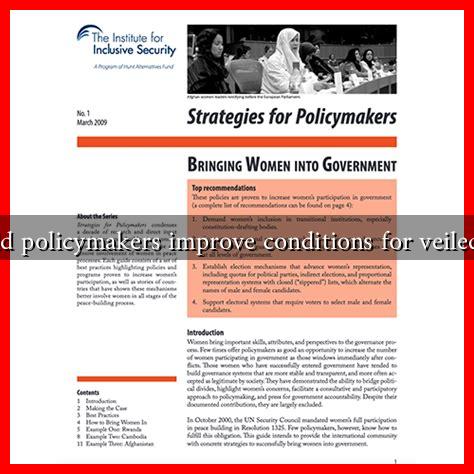-
Table of Contents
- How Could Policymakers Improve Conditions for Veiled Women?
- Understanding the Challenges Faced by Veiled Women
- Policy Recommendations for Improvement
- 1. Anti-Discrimination Legislation
- 2. Educational Initiatives
- 3. Employment Support Programs
- 4. Legal Protections for Religious Expression
- 5. Community Engagement and Support
- Case Studies: Successful Initiatives
- Conclusion
How Could Policymakers Improve Conditions for Veiled Women?
Veiled women, particularly those who wear the hijab, niqab, or burqa, often face unique challenges in various societies. These challenges can range from discrimination and social stigma to limited access to education and employment opportunities. Policymakers play a crucial role in shaping the environment in which veiled women live and work. This article explores several strategies that can be implemented to improve conditions for veiled women, ensuring their rights and dignity are upheld.
Understanding the Challenges Faced by Veiled Women
Before discussing potential solutions, it is essential to understand the challenges that veiled women encounter. These challenges can be categorized into several key areas:
- Discrimination: Veiled women often face prejudice in public spaces, workplaces, and educational institutions. This discrimination can manifest as verbal harassment, social exclusion, or even job loss.
- Limited Access to Education: In some regions, veiled women may be discouraged from pursuing education due to societal norms or institutional policies that favor non-veiled individuals.
- Employment Barriers: Many employers may harbor biases against veiled women, leading to fewer job opportunities and lower wages compared to their non-veiled counterparts.
- Legal Restrictions: In certain countries, laws may restrict the wearing of veils in public spaces, further marginalizing veiled women.
Policy Recommendations for Improvement
To address these challenges, policymakers can implement a range of strategies aimed at fostering inclusivity and equality for veiled women. Here are some actionable recommendations:
1. Anti-Discrimination Legislation
Policymakers should enact and enforce robust anti-discrimination laws that protect veiled women in various sectors, including education and employment. For instance, countries like Canada have implemented laws that prohibit discrimination based on religion, which can serve as a model for other nations.
2. Educational Initiatives
Creating educational programs that promote cultural sensitivity and awareness can help reduce stigma against veiled women. Schools and universities should incorporate curricula that educate students about different cultures and religions, fostering an environment of respect and understanding.
3. Employment Support Programs
Governments can establish programs that support the employment of veiled women, such as:
- Job Training: Offering vocational training programs tailored to the needs of veiled women can enhance their employability.
- Incentives for Employers: Providing tax incentives or subsidies to companies that hire veiled women can encourage more inclusive hiring practices.
- Networking Opportunities: Creating platforms for veiled women to connect with potential employers can help them find job opportunities.
4. Legal Protections for Religious Expression
Policymakers should ensure that laws protecting religious expression are upheld. This includes safeguarding the right to wear religious attire in public spaces and workplaces. Countries like France, which have faced controversies over the hijab, can learn from nations that successfully balance secularism with religious freedoms.
5. Community Engagement and Support
Encouraging community organizations to support veiled women can create a more inclusive environment. Initiatives could include:
- Support Groups: Establishing support networks for veiled women to share experiences and resources.
- Awareness Campaigns: Launching campaigns that highlight the contributions of veiled women to society can help combat stereotypes.
Case Studies: Successful Initiatives
Several countries have implemented successful initiatives to improve conditions for veiled women. For example:
- Germany: The country has introduced programs aimed at integrating Muslim women into the workforce, providing language courses and job placement services.
- Sweden: Sweden has a strong anti-discrimination framework that protects individuals from religious discrimination, contributing to a more inclusive society.
Conclusion
Improving conditions for veiled women requires a multifaceted approach that addresses discrimination, promotes education, and supports employment opportunities. By implementing anti-discrimination legislation, fostering educational initiatives, and engaging communities, policymakers can create a more inclusive environment for veiled women. As societies continue to evolve, it is crucial to ensure that all individuals, regardless of their attire, are afforded the rights and opportunities they deserve. For further reading on this topic, you can explore resources from organizations like the Human Rights Watch.

